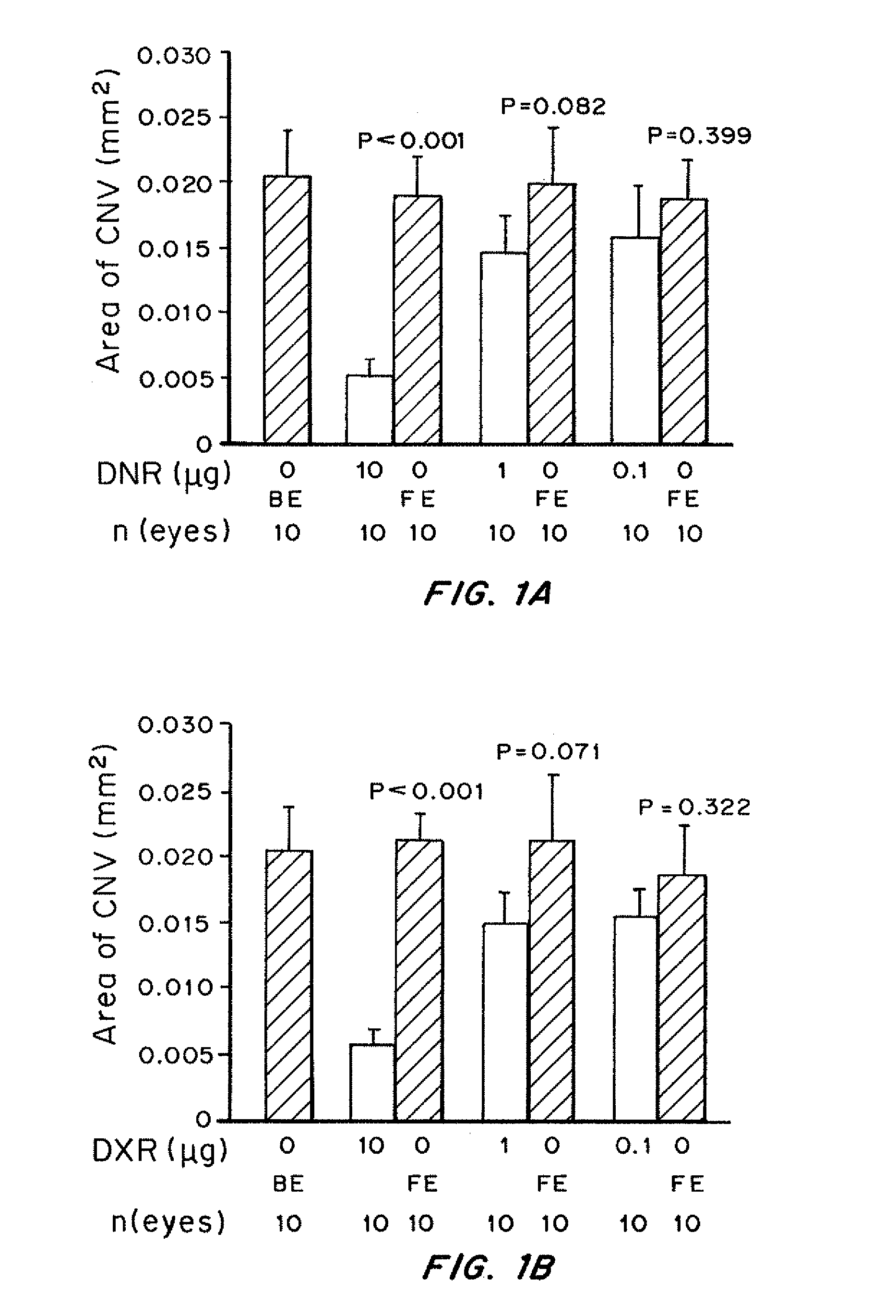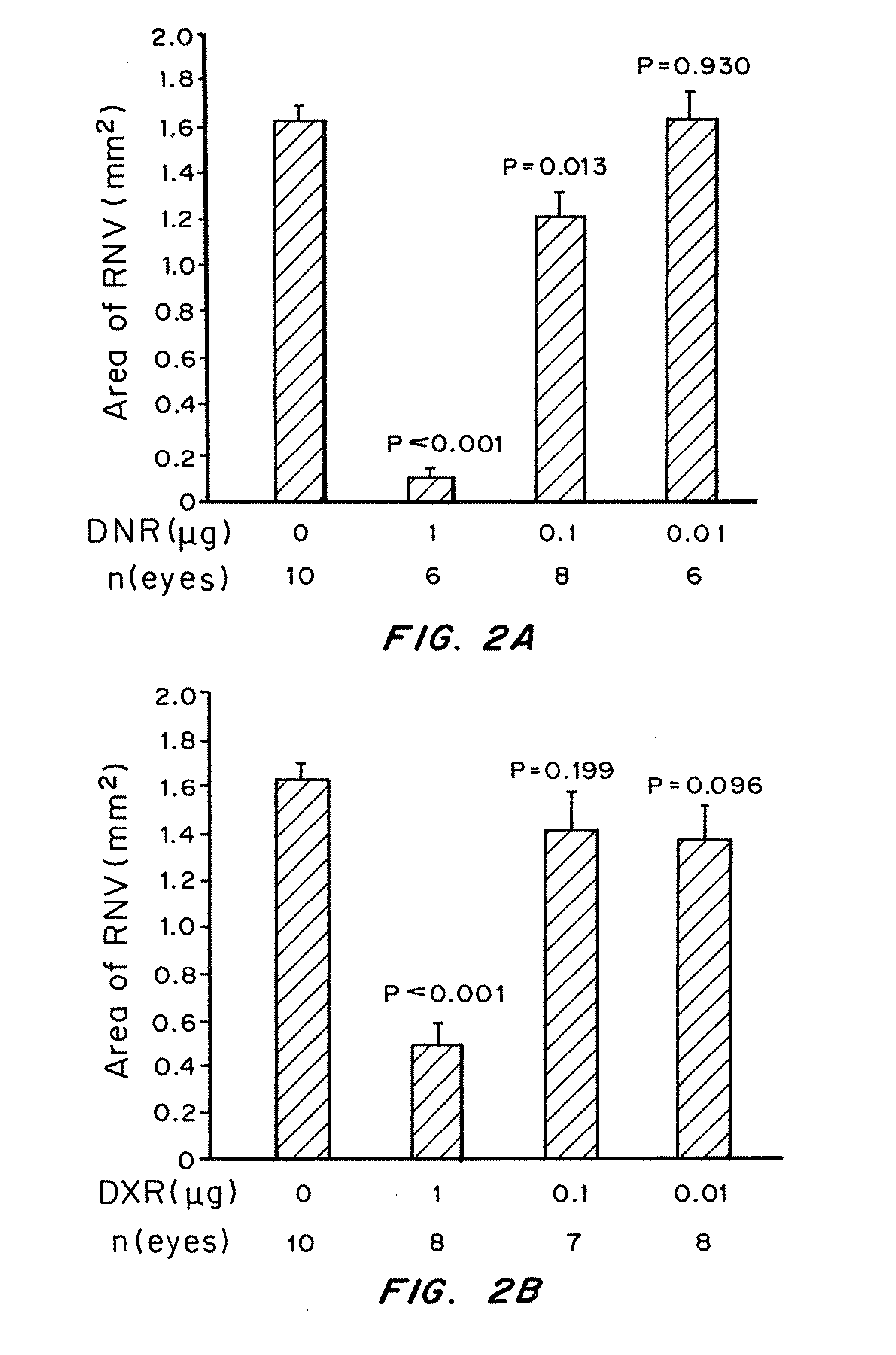Controlled Release Formulations for the Delivery of HIF-1 Inhibitors
a technology of hif-1 inhibitor and controlled release, which is applied in the direction of biocide, drug composition, cardiovascular disorder, etc., can solve the problems of difficult administration and maintaining a therapeutically effective amount of hif-1 inhibitor, many hif-1 inhibitors are cytotoxic, and exhibit significant side effects and/or toxicity, so as to prevent unacceptable levels of cytotoxicity, suppress intraocular neovascularization, and release longer
- Summary
- Abstract
- Description
- Claims
- Application Information
AI Technical Summary
Benefits of technology
Problems solved by technology
Method used
Image
Examples
example 1
Preparation of Polyanhydride-Drug Conjugate Particles Synthesis of Polymer
[0288](Polyethylene glycol)3-co-poly(sebacic acid) (PEG3-PSA) was prepared by melt polycondensation. Briefly, sebacic acid was refluxed in acetic anhydride to form a sebacic acid prepolymer (Acyl-SA). Citric-Polyethylene glycol (PEG3) was prepared using methods known in the art (Ben-Shabat, S. et al. Macromol. Biosci. 6:1019-1025 (2006)). 2.0 g of CH3O-PEG-NH2, 26 mg of citric acid, 83 mg of dicyclohexylcarbodiimide (DCC), and 4.0 mg of 4-(dimethylamino)pyridine (DMAP) were added to 10 mL of methylene chloride. This mixture was stirred overnight at room temperature, then precipitated, washed with ether, and dried under vacuum to isolate PEG3. Next, Acyl-SA (90% w / w) and PEG3 (10% w / w) were polymerized at 180° C. for 30 minutes. Nitrogen gas was swept into the flask for 30 seconds every 15 minutes. The reaction was allowed to proceed for 30 min. Polymers were cooled to ambient temperature, dissolved in chlorofo...
example 2
Treatment of Choroidal Neovascularization in a Mouse Model of CNV
[0295]Materials and Methods
[0296]Pathogen-free C57BL / 6 mice (Charles River, Wilmington, Mass.) were treated in accordance with the Association for Research in Vision and
[0297]Ophthalmology Statement for the Use of Animals in Ophthalmic and Vision Research and the guidelines of the Johns Hopkins University Animal Care and Use Committee.
[0298]Choroidal NV was induced by laser photocoagulation-induced rupture of Bruch's membrane as previously described (To be, T. et al., Am. J. Pathol. 135(5): 1641-1646 (1998)). Briefly, 5-6-week-old female C57BL / 6 mice were anesthetized with ketamine hydrochloride (100 mg / kg body weight) and pupils were dilated. Laser photocoagulation (75 μm spot size, 0.1 sec duration, 120 mW) was performed in the 9, 12, and 3 o'clock positions of the posterior pole of each eye with the slit lamp delivery system of an OcuLight GL diode laser (Iridex, Mountain View, Calif.) and a handheld cover slip as a...
example 3
Pharmacokinetic Study in Rabbits
[0329]Materials and Methods
[0330]Preparation of the PEG3-PSA Polymer
[0331](Polyethylene glycol) 3-co-poly(sebacic acid) (PEG3-PSA) was synthesized by melt condensation. Briefly, sebacic acid was refluxed in acetic anhydride to form sebacic acid prepolymer (Acyl-SA). Polyethylene glycol (PEG3) was prepared by mixing CH3O-PEG-NH2 (2.0 g), citric acid (26 g), dicyclohexylcarbodiimide (DCC; 83 mg) and 4-(dimethylamino)pyridine (DMAP, 4.0 mg) which were added to 10 mL methylene chloride, stirred overnight at room temperature, then precipitated and washed with ether, and dried under vacuum. Next, acyl-SA (90% w / w) and PEG3 (10% w / w) were polymerized at 180° C. for 30 mins. Nitrogen gas was swept into the flask for 30 seconds every 15 minutes. Polymers were cooled to ambient temperature, dissolved in chloroform and precipitated into excess petroleum ether. The precipitate was collected by filtration and dried under vacuum to constant weight, to produce the P...
PUM
| Property | Measurement | Unit |
|---|---|---|
| solubility | aaaaa | aaaaa |
| concentration | aaaaa | aaaaa |
| polymeric | aaaaa | aaaaa |
Abstract
Description
Claims
Application Information
 Login to View More
Login to View More - R&D
- Intellectual Property
- Life Sciences
- Materials
- Tech Scout
- Unparalleled Data Quality
- Higher Quality Content
- 60% Fewer Hallucinations
Browse by: Latest US Patents, China's latest patents, Technical Efficacy Thesaurus, Application Domain, Technology Topic, Popular Technical Reports.
© 2025 PatSnap. All rights reserved.Legal|Privacy policy|Modern Slavery Act Transparency Statement|Sitemap|About US| Contact US: help@patsnap.com



